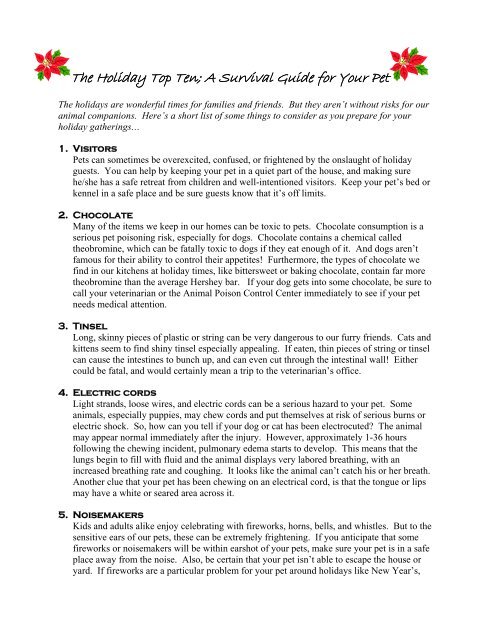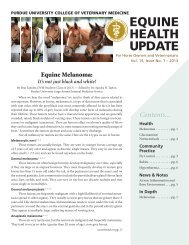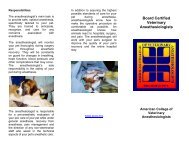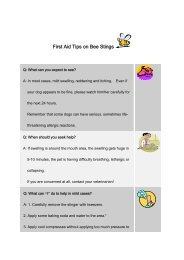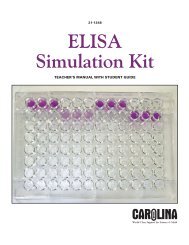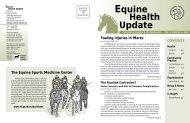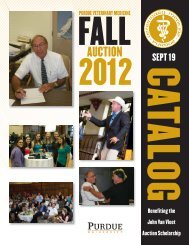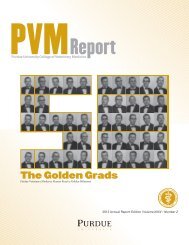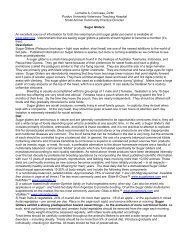The Twelve Days of Christmas; A Holiday Survival Guide for Your Pet
The Twelve Days of Christmas; A Holiday Survival Guide for Your Pet
The Twelve Days of Christmas; A Holiday Survival Guide for Your Pet
You also want an ePaper? Increase the reach of your titles
YUMPU automatically turns print PDFs into web optimized ePapers that Google loves.
<strong>The</strong> <strong>Holiday</strong> Top Ten; A <strong>Survival</strong> <strong>Guide</strong> <strong>for</strong> <strong>Your</strong> <strong>Pet</strong><strong>The</strong> holidays are wonderful times <strong>for</strong> families and friends. But they aren’t without risks <strong>for</strong> ouranimal companions. Here’s a short list <strong>of</strong> some things to consider as you prepare <strong>for</strong> yourholiday gatherings…1. Visitors<strong>Pet</strong>s can sometimes be overexcited, confused, or frightened by the onslaught <strong>of</strong> holidayguests. You can help by keeping your pet in a quiet part <strong>of</strong> the house, and making surehe/she has a safe retreat from children and well-intentioned visitors. Keep your pet’s bed orkennel in a safe place and be sure guests know that it’s <strong>of</strong>f limits.2. ChocolateMany <strong>of</strong> the items we keep in our homes can be toxic to pets. Chocolate consumption is aserious pet poisoning risk, especially <strong>for</strong> dogs. Chocolate contains a chemical calledtheobromine, which can be fatally toxic to dogs if they eat enough <strong>of</strong> it. And dogs aren’tfamous <strong>for</strong> their ability to control their appetites! Furthermore, the types <strong>of</strong> chocolate wefind in our kitchens at holiday times, like bittersweet or baking chocolate, contain far moretheobromine than the average Hershey bar. If your dog gets into some chocolate, be sure tocall your veterinarian or the Animal Poison Control Center immediately to see if your petneeds medical attention.3. TinselLong, skinny pieces <strong>of</strong> plastic or string can be very dangerous to our furry friends. Cats andkittens seem to find shiny tinsel especially appealing. If eaten, thin pieces <strong>of</strong> string or tinselcan cause the intestines to bunch up, and can even cut through the intestinal wall! Eithercould be fatal, and would certainly mean a trip to the veterinarian’s <strong>of</strong>fice.4. Electric cordsLight strands, loose wires, and electric cords can be a serious hazard to your pet. Someanimals, especially puppies, may chew cords and put themselves at risk <strong>of</strong> serious burns orelectric shock. So, how can you tell if your dog or cat has been electrocuted? <strong>The</strong> animalmay appear normal immediately after the injury. However, approximately 1-36 hoursfollowing the chewing incident, pulmonary edema starts to develop. This means that thelungs begin to fill with fluid and the animal displays very labored breathing, with anincreased breathing rate and coughing. It looks like the animal can’t catch his or her breath.Another clue that your pet has been chewing on an electrical cord, is that the tongue or lipsmay have a white or seared area across it.5. NoisemakersKids and adults alike enjoy celebrating with fireworks, horns, bells, and whistles. But to thesensitive ears <strong>of</strong> our pets, these can be extremely frightening. If you anticipate that somefireworks or noisemakers will be within earshot <strong>of</strong> your pets, make sure your pet is in a safeplace away from the noise. Also, be certain that your pet isn’t able to escape the house oryard. If fireworks are a particular problem <strong>for</strong> your pet around holidays like New Year’s,
talk to your veterinarian about the possibility <strong>of</strong> getting some medications to help your petthrough these stressful times.6. OrnamentsAs you deck the halls, trim the tree, or light the menorah, keep in mind that pets don’tunderstand the words “breakable,” “family heirloom,” or “sentimental value.” Rambunctiousdogs, cats, and ferrets have been known to topple many an ornament and knick-knack, andsometimes even whole <strong>Christmas</strong> trees. You can help prevent breaks and mishaps bykeeping weighty ornaments close to the floor, and valuable ornaments out <strong>of</strong> reach fromcurious mouths, noses, and wagging tails. Keep knick-knacks on shelves inaccessible to youranimal companions. Also, make sure <strong>Christmas</strong> trees are tethered to a nearby wall orwindow frame if you have ferrets or cats fond <strong>of</strong> climbing!7. Candles<strong>The</strong> dancing flames and shadows thrown by candles are tantalizing to pets. But disaster canstrike in an instant if a candle is toppled by a curious animal, or worse still, if a pet setshim/herself alight. Of course, candles should never be left burning unattended. But alsomake sure pets are kept a safe distance from lit candles <strong>for</strong> their own safety and ours.8. Decorative PlantsSome plants and greenery like Holly, Ivy, and Mistletoe can be very toxic if a pet ingeststhem. For a full list <strong>of</strong> toxic plants, you can check http://www.aspca.org/pet-care/poisoncontrol/If you have an emergency, you can call the animal poison control hotline at 1(888) 426-4435.9. OvereatingWe aren’t the only ones who sometimes take too much <strong>of</strong> a good thing. Table scraps,garbage raiding, and counter surfing can add up to lots <strong>of</strong> rich food in your pet’s stomach,which may lead to stomach upset. Even worse, too much rich food can lead to seriousinflammation <strong>of</strong> the pancreas, which can be life-threatening. Stick to your pet’s normal dieteventhough he/she may encourage you not to!
10. New <strong>Pet</strong>sMany <strong>of</strong> us love the thought <strong>of</strong> surprising somebody with a new puppy or kitten on<strong>Christmas</strong> morning. Un<strong>for</strong>tunately, it’s difficult to find a time that’s worse <strong>for</strong> bringing anew pet into the home! <strong>The</strong> holiday household is full <strong>of</strong> hustling and bustling, decorations,toys, treats, and sometimes even a little bit <strong>of</strong> stress! All <strong>of</strong> the excitement can cause a newpet to be confused or overstimulated. If you’ve decided it’s time <strong>for</strong> a new family member,wait until the week AFTER the holiday, puppy- or kitten-pro<strong>of</strong> the house, and introduce yournew pet into a quiet, safe environment. Don’t <strong>for</strong>get to ask your veterinarian <strong>for</strong> advice onselecting your new pet!


